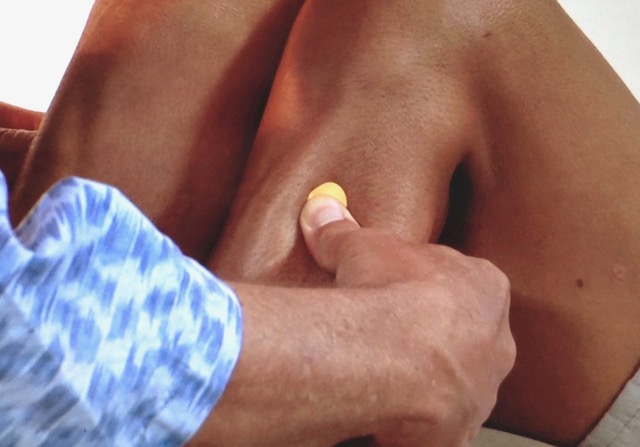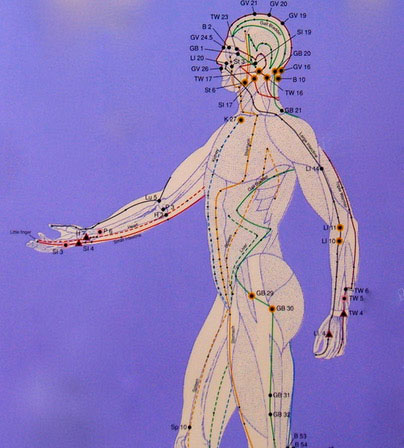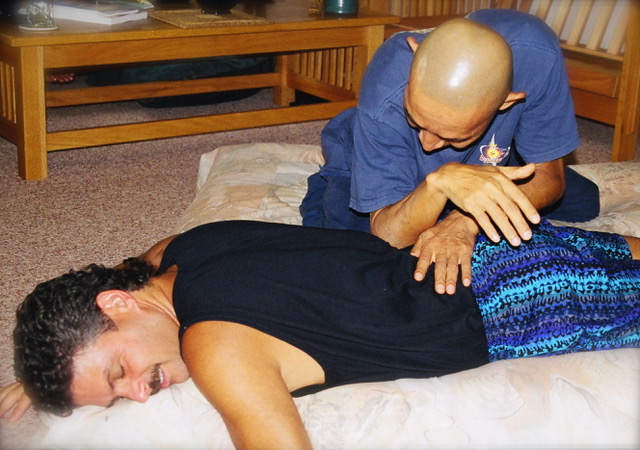Acupressure Styles, Methods & Forms
Learn Acupressure Point Techniques
 How to Use Acupressure
How to Use AcupressureThis article offers a detailed, comprehensive look at how to use Acupressure. The topics covered include basic Acupressure methods, Acupressure techniques, how much pressure to use, Acupressure Meridians, and how to use deep breathing to enhance Acupressure.
For a complete Acupressure introduction, see the Acupressure Points page. As a beginning Acupressure student, it will give you a good overview of what you need to know to start using Acupressure as a healing art.
Learn how to skillfully apply pressure to Acupressure Points, and understand how to find their location by checking out the Pressure Point Applications page.
For experienced Acupressure Practitioners visit the Advanced Acupressure Instruction page to study Acupressure therapy more in depth.
Basic Acupressure Methods & Acupressure Techniques
The middle finger is the longest and strongest of your fingers; it’s one of the best suited Acupressure methods for applying finger pressure to the points on yourself and others. You can use the middle finger alone, or with your index and ring fingers on either side as support. The thumb is strong, too, but often lacks sensitivity.
If you find that your hand is generally weak or hurts when you apply finger pressure, you can use your knuckles or your fist. There are other Acupressure tools you can use to reduce stress on your hands such as a tennis ball, an avocado pit, a golf ball, or a pencil eraser.
Many people need light pressure or touch. People with fibromyalgia, chronic fatigue and generally sensitive individuals much prefer to have their Acupressure points held gently. A person with a sensitive body, requires this light touch.
A basic Acupressure method uses prolonged finger pressure directly on the Acupressure Points. Gradual, steady, penetrating pressure for approximately two to three minutes is ideal. Hold the Point until you feel a clear, regular pulse or until any soreness or stiffness diminishes. Then slowly decrease the finger pressure, ending with about twenty to thirty seconds of light touch.
For Pain Relief
When you’re working on an area that is painful, you may find that this basic Acupressure method releases the point and the muscular tension. As this occurs, the pain often moves. By holding the point steady for a prolonged time, endorphins are released into the bloodstream which reduces pain. As this occurs, the pain subsides or can actually move. Just follow it by moving your hand over a bit and remind yourself to breathe slowly and deeply.
Although you may be tempted to massage or rub the entire area, one of the most effective Acupressure techniques is to hold an Acupressure Point steadily with direct finger pressure. The rule of thumb is to apply slow, firm pressure on the point at a 90-degree angle from the surface of the skin. If you are pulling the skin, then the angle of pressure is incorrect.
You can learn more about the many ways Acupressure can be used to help with pain in many areas of the body in the Acupressure Pain Relief eBook. It also includes self-care techniques for arthritis, fibromyalgia, and headaches, and has easy Daily Routines to relieve and also prevent pain.
Apply Pressure Gradually
The biggest mistake an Acupressure beginner tends to make is to press points too fast. The fast velocity of the pressure causes pain. It’s important to remind yourself to go into the points slowly.
Consciously and gradually direct the pressure into the center of the part of the body you are working on. It’s important to apply and release finger pressure gradually, because this allows the tissues time to respond, which promotes healing. The better your concentration as you move your fingers slowly into and out of the Acupressure Point, the more effective the treatment will be, especially for stress and pain relief.
An Acupressure session is a time to relax and tune into your body. Take your time, work slowly and steadily, and be sure to go slowly in and out of the Point. It’s better to hold fewer Points in a session than to hold more but rush through them. In general, a Self-Acupressure session might be 20 to 30 minutes. You can do more, but as a beginning Acupressure student or practitioner, limit your sessions to an hour at the most.
Timing for Holding the Points
As a beginning Acupressure practitioner, you may find that you are most comfortable holding a point for one or two minutes. You may find that over time – two to three months – you can gradually work up to holding Points longer. However, do not hold any one Point longer than 10 minutes. Also, do not work any single area of the body, such as the abdominal area or the face, for longer than 15 minutes.
As with Acupuncture, the effects of Acupressure can be quite strong. If you work too long, too much energy is released and complications, such as nausea and headaches, can occur. It’s easy to avoid these problems by working in a balanced way and not over-doing it. For professional Acupressure guidance and training, see the Acupressure Mastery Program.
Hand Fatigue
If your hand starts to ache from pressing a Point, slowly decrease the pressure and slowly remove your hand from the point. Gently move your fingers to relax your hand as you take several deep breaths. Return to the Point once your hand relaxes and slowly apply the pressure into the point once again.
How Much Pressure to Use
Each Point will feel somewhat different when you press it. Some Points feel tense or rigid, while others are often sore or achy. How much pressure to apply to any Acupressure Point depends on how fit you are and the location of the Point. A general guideline to follow using all Acupressure techniques is that the pressure should be firm enough so that it “hurts good” – in other words, something between pleasant, firm pressure and outright pain.
Soreness or Sensitivity to Pain
If you feel extreme (or increasing) sensitivity or pain, gradually decrease the pressure until you find a balance between pain and pleasure. Acupressure is not meant to increase your tolerance of pain, so do not think of it as a test of endurance. Do not continue to press an Acupressure Point that is excruciatingly painful, or only use a light touch. Usually, however, if you hold the point steady and long enough, for two to three minutes, the pain will diminish.
Fitness & Muscles
An individual person’s fitness must be taken in account in determining how much pressure to use. The more muscular a person is, the more pressure you should apply to the Acupressure Points. Someone who is less muscular and more sensitive needs a lighter and gentler touch.
Body Location
Some parts of the body have more developed muscles and others are naturally more sensitive. You can use a deeper, firmer pressure, for example, on the large muscles of the back, buttocks, and shoulders, but only use lighter pressure on the calves, the backs of the knees, or the face.
For example, some of the exercises in the Acu-Face Lift eBooklet use a light touch. The Chinese have used Acupressure to enhance beauty for thousands of years, so one of the benefits of Acupressure is for Beauty & Toning Treatments.
Pressure Points Depths
Each Acupressure Point is located at a certain depth from the surface of the body, and this can vary quite a bit from Point to Point. Of course, the depth of a Point affects how much pressure you need to use to reach the Point.
For example, Points in the buttocks area – which has the largest muscles in the body, the gluteus maximus – may be up to 3 inches deep. The Acupressure method on a more muscular person or part of the body is to use deeper pressure into the Points. More pressure is then needed to stimulate the body’s healing energy.
However, most of the Points below the knees and elbows are more shallow. They may be located only one quarter of an inch in depth. Thus, they would need less pressure to be properly stimulated.
Difficult to Reach
Certain areas of the body, such as the back and shoulders, are hard to reach. For these areas, I recommend using Acu-Yoga postures. These use your whole body in Yoga postures to apply the proper amount of pressure to the Acupressure Points.
See the Acupressure Books page to find Acu-Yoga, which includes many complete routines based on the Acupressure Meridians, the Yoga Chakras, and various specific conditions, including back problems, shoulder and neck tension, indigestion, eye problems, and many more.
Acupressure Meridians
The 12 Organ Meridians are distinct channels that circulate life energy through these healing points. The Acupressure Meridians connect the pressure Points with all organs and functions of the body, including the senses and emotions, nourishing all systems. This includes the endocrine glands, lymph, blood, muscles, and nerves.
 Learn how to visualize these energy channels with the 12 Meridians mp3. This audio program provides detailed information about each Meridian and includes guided imagery and Acu-Yoga exercises.
Learn how to visualize these energy channels with the 12 Meridians mp3. This audio program provides detailed information about each Meridian and includes guided imagery and Acu-Yoga exercises.
Acupressure Point Reference Numbers
To practice Self-Acupressure, you don’t need to know the system of naming and numbering the Points that generates the Acupressure Point reference numbers. But it can be helpful to understand more of what these numbers are referring to, since you will often see them as you explore all the wealth of material on this Acupressure.com website.
The pressure Point reference numbers are based on abbreviations of the names of the Acupressure Meridians. For example, Lu 1 means the first Point on the Lung Meridian, and Lv 3 is the third Point on the Liver Meridian. Here’s the list of the 12 Acupressure Meridians, in the order of their flows in the body.
| Lu Lung – Acupressure Meridian | B Bladder – Acupressure Meridian |
| LI Large Intestine – Acupressure Meridian | K Kidney – Acupressure Meridian |
| St Stomach – Acupressure Meridian | P Pericardium – Acupressure Meridian |
| Sp Spleen – Acupressure Meridian | TW Triple Warmer – Acupressure Meridian |
| H Heart – Acupressure Meridian | GB Gall Bladder – Acupressure Meridian |
| SI Small Intestine – Acupressure Meridian | Lv Liver – Acupressure Meridian |
Acupressure’s Extraordinary Vessels
There are other Acupressure channels, known as Extraordinary Vessels, that also exist in the body. Two of the most widely used Extraordinary Vessels travel along the midline of the body, on both the front and back. Acupressure Points are also found along these Central channels: Conception Vessel (CV), and Governing Vessel (GV).
Acupressure Techniques & Styles
These ancient Points are common to all styles of Acupressure, but a variety of ways to use them have been developed in different Asian traditions. Each Acupressure technique has distinctive characteristics that incorporate unique ways of either practicing Self-Acupressure or working with others. The styles differ in the length of time the Points are pressed and the ways they are stimulated.
Jin Shin was developed in Japan by Jiro Murai, who rediscovered the ancient chi flow (bioenergy) in his own body and mapped a powerful healing system of Points. Combinations of Acupressure Points are held with the fingertips for a minute or more, usually with the client lying on his or her back.
The Jin Shin style of holding or using Reiki on the Points is good for more sensitive body types (yin conditions), for relieving pain, and for emotional healing.
 Shiatsu (literally, “finger pressure”) is also Japanese in origin. This well-known method can be quite vigorous. It uses firm rhythmic pressure on the Points for only three to five seconds (using the thumbs in the Namakoshi style), following a sequence of Points designed to awaken the Acupressure Meridians.
Shiatsu (literally, “finger pressure”) is also Japanese in origin. This well-known method can be quite vigorous. It uses firm rhythmic pressure on the Points for only three to five seconds (using the thumbs in the Namakoshi style), following a sequence of Points designed to awaken the Acupressure Meridians.
Shiatsu is effective for more muscular, strong, stocky, sturdily built individuals (yang conditions). It’s good for toning and releasing overall muscular tension and increasing circulation. The Shiatsu technique of leaning your body weight into your client’s Points allows you to apply deeper pressure without any strain.
Learn more in a fully illustrated instructional Shiatsu booklet. It provides 50 traditional Shiatsu techniques.
Zen Shiatsu is a creative, whole-body Shiatsu style utilizing stretches, leverage, and rhythmic breathing to awaken the healing channels of the body. The Zen Shiatsu video has a one-hour demonstration and explanation of how to give a complete Zen Shiatsu treatment.
Barefoot Shiatsu uses various parts of the foot. This also gives the practitioner the added advantage of leaning with his or her body weight to apply the pressure.
Acu-Yoga and Do-In (Self-Acupressure Massage) are two Acupressure techniques designed specifically for self application. Acu-Yoga uses whole body postures along with deep breathing, finger pressure, meditations, and stretches. Do-In also incorporates body awareness, stretching, and breathing, but focuses on various self-care Acupressure techniques that stimulate the Points and Acupressure Meridians.
Tui Na is a vigorous and subtle Chinese massage using a variety of hand movements to increase the circulation of blood and chi.
Thai Massage utilizes a series of powerful full-body stretches and advanced Acupressure techniques.
More Acupressure Techniques
To help you individualize each Acupressure Meridian session, you can learn different approaches to applying pressure to the Points. Here are some examples of ways to stimulate the Points which make for unique Acupressure techniques.
 Firm finger pressure is the most fundamental Acupressure technique. Use thumbs, fingers, palms, the side of the hand, or knuckles to apply steady, focused, stationary pressure. To relax an area or relieve pain, apply finger pressure gradually and hold without any movement for several minutes at a time.
Firm finger pressure is the most fundamental Acupressure technique. Use thumbs, fingers, palms, the side of the hand, or knuckles to apply steady, focused, stationary pressure. To relax an area or relieve pain, apply finger pressure gradually and hold without any movement for several minutes at a time.
One minute of steady thumb or finger pressure, when applied gradually, calms and relaxes the nervous system, promoting greater healing. To stimulate the area, apply your thumbs or finger pressure for only four or five seconds.
Slow motion kneading uses the thumbs and fingers, along with the heels of the hands, to squeeze large muscle groups firmly. The motion is similar to that of kneading a large mass of dough. When working on a client, one way to use this technique is to simply lean the weight of your upper body into the muscle as you press the area. This will help the muscle become more soft and pliable.
This Acupressure technique relieves general stiffness, shoulder and neck tension, constipation, and spasms in the calf muscles.
Brisk rubbing uses friction to stimulate the blood and lymph. Rub the skin lightly to relieve chilling, swelling, and numbness by increasing circulation. This also benefits the tone and nerves of the skin.
Quick tapping with fingertips stimulates muscles on unprotected, tender areas of the body, such as the face. For larger areas of the body, such as the back or buttocks, use a loose fist. This Acupressure technique can improve the functioning of nerves and sluggish muscles in the area.
Caution
If you have a serious or life-threatening illness, or a chronic medical problem, such as heart disease, cancer, or high blood pressure, you should not use the following techniques: brisk rubbing, deep pressure, kneading, or anything else that feels overstimulating.
Instead, use a light touch or a gentle medium pressure to activate the healing energy of the Acupressure Points.
Deep Breathing & Acupressure
Breathing is the most profoundly effective tool for purifying and revitalizing the body. When your breath is shallow, all your body’s vital systems function at a minimum level. If your breath is long and deep, however, the respiratory system functions properly, and the body cells become fully oxygenated.
Deep breathing helps the Acupressure Points release any stiffness, soreness, tension, or pain. The Acupressure method of activating pressure Points while breathing deeply encourages healing energy to flow throughout the body. As you practice various Acupressure techniques and concentrate on breathing deeply into your abdomen, you will help your body heal itself, experience Tension & Stress Relief, and also generate a great feeling of well-being.
Concentrated breathing can especially help you better release a pressure Point that is painful. Close your eyes, focus your attention on the painful spot, breathe deeply, and imagine that you are breathing healing energy into the affected area, as you gently press Points and balance the Acupressure Meridians.
Basic Acupressure Breathing Technique
As you use finger pressure to hold the Points, inhale deeply into the abdomen, letting your belly expand. Feel the breath reach into the depths of the belly. Exhale slowly, letting the energy that you drew in now circulate throughout your body. Hold the Point with a steady touch, not using a massaging movement. Focus on breathing healing energy into the Point for three full minutes.
Often, poor circulation is indicated by a Point that is sore when pressed. By taking long, deep breaths and pressing gently for three minutes, you will close the nervous system’s pain gates, improve the circulation, and help the area heal.
This basic Acupressure method with deep breathing will enhance the healing benefits of any Acupressure technique you do. You will get the best results by practicing deep breathing as your finger pressure opens the points.
